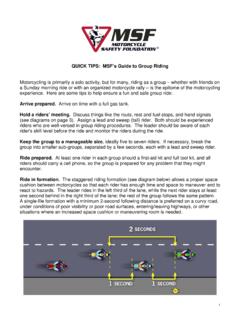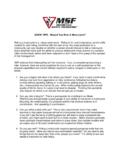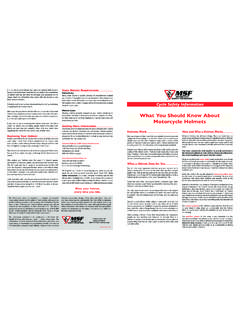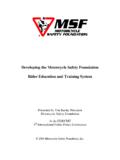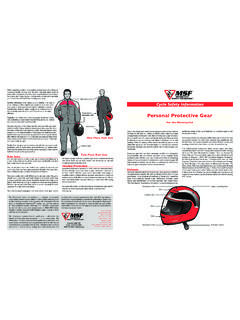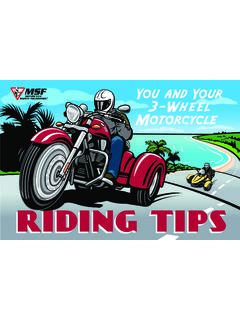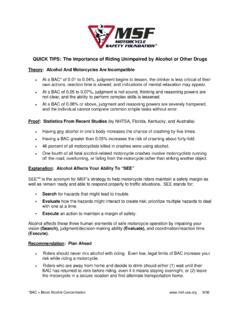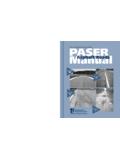Transcription of T-CLOCS Pre-Ride Check - Motorcycle Safety …
1 First Edition: May 2003; Third Printing, March 2004 Copyright 2003 Motorcycle Safety Foundation, rights reserved. No part of this publication may be reproduced or transmittedin any form or by any means, electronic or mechanical, including photocopy,recording, or any information and retrieval system, without permission in writingfrom the Motorcycle Safety Foundation (MSF). Under no circumstances may thematerial be reproduced for resale. Please send request in writing toCommunications Dept., Motorcycle Safety Foundation,2 Jenner St., Ste. 150, Irvine, CA Pre-Ride Check2 The 4 Preps4 Ladder of Risk6 Total Stopping Distance8 SEE10 RiderRadarSM12 Car/ Motorcycle Crashes14 Motorcycle -Only Crashes16 Traction Patches18 Alcohol/Drug Effects20 Safety Oval22 Additional Information24 Table of ContentsClassroom Cards1T-CLOCS Pre-Ride Check Card 12 MSF Experienced RiderCourse SuiteSMT - Tires and WheelsDeficientOKNotesCondition TreadAir PressureC - Controls(Levers, Cables, Throttle)ConditionOperationRoutingL - LightsLens/Reflector ConditionIlluminationO - OilOil LevelC - Chassis(Forks, Swing Arm, Shocks, Chain/Belt)ConditionS - Side StandConditionRetentionKey Points:1.
2 T-CLOCS is a system for completing a Pre-Ride Check . It can be usedbefore each ride as a quick Safety Check and is also a good way toapproach a more detailed Motorcycle inspection. A habitual Check ofthe Motorcycle will help prevent more costly corrective Refer to the owner s manual for specific recommendations. It hasrecommended intervals for maintenance and provides specifics abouta particular Motorcycle model. It is a good idea to read the owner smanual occasionally to learn more about a Motorcycle and its A Pre-Ride inspection should be a routine process. Just like a car or truck,a Motorcycle will operate like it is new if it is maintained properly andregularly. Not only is there a cost savings but a rider can be assured thatthe Motorcycle will respond precisely to every control Pre-Ride CheckClassroom Cards3 Size/FitMotorcycleProtective GearMentalThe 4 Preps Card 24 MSF Experienced RiderCourseSuiteSMThe 4 PrepsClassroom Cards5 Key Points:1.
3 Preparation is a key to safe and responsible riding. A rider can be at abetter advantage when How a rider fits a Motorcycle can affect handling. It is important thatcontrols can be reached easily and that the operation is smooth withoutrequiring too much strength or T-CLOCS is a system for a Pre-Ride Check . It is also useful for moreextensive maintenance procedures. A Motorcycle will operate like it isnew if properly Protective gear is for comfort and protection. Riders should dress forthe ride , not for the crash. A helmet manufactured to meet the of Transportation standards is critically important. Otherimportant protective gear is eye protection, long sleeves and sturdypants, full-fingered gloves and over-the-ankle footwear. Well-designedmotorcycle gear keeps a rider comfortable and better protected in theevent of a Riding safely requires a rider s mind to be distraction-free and safetyfocused. Inattention is a major factor in Motorcycle crashes.
4 A safe riderwill watch for hazards well ahead and keep the eyes and mind searchingand evaluating Carrying a passenger may require some adjustments to the suspensionand tires. Refer to a Motorcycle s owner s manual to discover specificadjustments. Follow the manufacturer s Refer often to the owner s manual to review proper and recommendedsetup and adjustments. This is important when first riding a motorcycleas well as during routine Aging affects the ability to read the gauges, so larger and well-lighteddials may be beneficial. Older riders can benefit from gauges that havelarge letters and numerals. Instrument clusters that are well illuminatedfor night riding can be advantageous of Risk Card 36 MSF Experienced RiderCourse SuiteSMClassroom Cards7 Key Points:1. The Ladder of Risk is a way to think about risk management. Each rungof the ladder can be thought of as a factor that contributes to risk. Themore factors there are, the more risk there Good riders stay low on the ladder and minimize the factors that mightaccumulate and lead to a crash.
5 A good strategy is to reduce the factorsover which a motorcyclist has control, such as speed, lane position andpath of Factors are introduced into the traffic mix by the rider, the Motorcycle ,and the road and traffic conditions. The rider can contribute to risk by notpaying complete attention or riding too fast for conditions. A motorcyclecan contribute to risk by having under-inflated tires or lights not function-ing properly. The road can contribute factors by having bumps, ridges or aloose and slippery surface. Traffic can contribute to risk by drivers that areless then perfect in their ability to see and react to others in riders take more risks than others. Statistics show that younger ridersand older riders have more than their share of crashes. Riders who are justlearning to ride and riders who are getting older should take special pre-cautions to minimize risk and reduce their can reduce risk to a certain degree if they choose to.
6 Riders canapply a thinking strategy to ensure a safe and adequate Safety riders will think about what they can do to improve their Safety . Arider can control such things as how fast to ride through a curve or howmuch time and space to have when negotiating an Part of riding safely is to reduce moment-to-moment risks. Different ridingsituations produce different risks. Riders must be aware of situations asthey develop. When approaching a curve or an intersection, riders can takespecific actions to increase their margin of Aging can result in additional factors that could increase risk, such aschanges in vision, reaction to hazards, and control manipulation. Agingaffects visual acuity as well as the ability to see at night. Older riders canhave greater difficulty in identifying factors as they accumulate in traffic,particularly when changing lanes or selecting a gap in traffic. Agingaffects strength and could adversely affect the ability to brake andswerve with of RiskTotal Stopping Distance Card 48 MSF Experienced RiderCourse SuiteSMTotal Stopping DistanceClassroom Cards9 Key Points:1.
7 Total Stopping Distance consists of 3 parts. Riders can put themselvesat an advantage by thinking about how to improve behavior andperformance in each of the three Perception time/distance is the time it takes or the distance a ridertravels from when factors are developing until recognized as a can improve perception time by seeing the big picture and watchingwell ahead for factors that could affect a line of sight or a path Reaction time/distance is the time it takes or the distance a rider travelsfrom when a problem is perceived until braking begins. Riders canimprove reaction by anticipating problems and having a preparedresponse. For example, covering the brakes or being ready to pressin the direction of a swerve can save precious feet that could makea Braking time/distance is the time it takes or the distance a rider travelsfrom when brakes are applied until stopped. Braking distance can beimproved by having a well-maintained Motorcycle and by practicingquick stops often.
8 It is wise to find an empty parking lot to refine goodbraking skills so an emergency braking response is quick and The Safety margin comes mostly from increasing the time and distanceto perceive factors and recognize the interaction of factors. Riders havethe best opportunity to increase their Safety margin by looking for andidentifying the factors that interact to cause risk. This way they canadjust speed and lane position to avoid the need to make an Carrying a passenger increases total stopping distance. This is becauseof the increased weight the Motorcycle is Total stopping distance is lengthened due to slower reaction timesassociated with aging. Older riders may not identify traffic hazards orrespond to emergencies as well as they did when they were younger. Asolution is to allow more time and space and rely on better perceptivecapabilities as well as wiser use of a Safety Card 510 MSF Experienced RiderCourse SuiteSMSearchEvaluateExecuteSEE Classroom Cards11 Key Points:1.
9 SEE (Search, Evaluate, Execute) is a strategy to reduce risk. It means tosearch for factors that will increase risk or affect time and space margins,to think about how factors can interact to form risky situations, and toreact to potential problems by adjusting speed or lane position beforean emergency response is We search for factors that affect Safety margins. A Safety margin is thetime and space riders create to avoid making an emergency can be related to other traffic or it can be related to rider-specificrisks such as speed through curves where there is a chance for a fall orrunning off the road. Factors could be things riders introduce themselveslike inattention or riding too fast for conditions, or even a cavalier atti-tude that nothing will even happen because I m a good rider and canreact in time to anything that happens. Factors could be things relatedto the Motorcycle such as low tire pressure or poorly maintained could be things related to road conditions such as gravel ordebris in a curve or obstacles such as mufflers or rocks.
10 Factors could bethings related to traffic such as poorly illuminated signs or road mark-ings, or even inattentive or poorly skilled drivers of other Risks are evaluated by determining the interaction of several factors. Athinking motorcyclist is one who plays the what if game by constantlyfiguring out what can happen to increase risk. Examples might be imag-ining that an approaching car will fail to yield, or imagining that aroundthe next curve is loose gravel on the road. It is more than just reactingquickly to problems but rather figuring out what could Being able to evaluate factors before a conflict occurs requires complete attention to the riding task is not easy. There are manythings that can distract from complete attention toward Riding safely (keeping a Safety margin) is more a skill of the eyes andmind than of the hands and feet, but we need both kinds of skill. It hasbeen said that superior riders are those who utilize a superior ridingstrategy so as not to have to use their superior maneuvering Riders should have a planned escape for potential conflicts.
